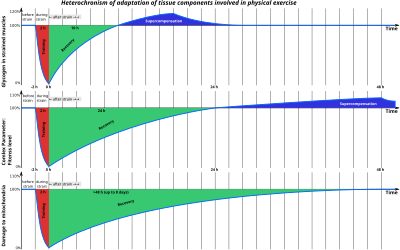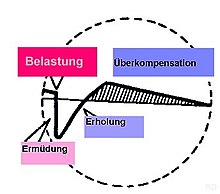Supercompensation

Under super-compensation means a model that shows how adjustment processes ( adaptation ) in the context of sports training run.
Description of the principle
The principle of supercompensation states that after a training load , the body not only restores the readiness to provide the same level of performance, but also increases performance beyond the original level over the course of recovery ( regeneration ) and maintains it at this level for a certain period of time (cf. . Illustration).
If this higher level of performance is used for the new training unit, the result is an increase in performance that is sustained over a longer period of time, but limited upwards. If the regeneration phase between training loads is too great, the training effect is lost again. If, on the other hand, you train too much and / or too intensively, the body does not have enough time to regenerate and the performance level drops ( overtraining ).
Accordingly, the schematic model of supercompensation can be divided into 5 phases:
- The initial state is self-regulation (homeostasis).
- The disruption of homeostasis due to physical exercise with a loss of performance. At this point the graph sinks.
- The recovery phase, the graph returns to its initial level.
- The phase of excessive restoration. In this phase the graph reaches its maximum.
- Since adaptations (performance improvement) of the body are reversible, the performance slowly decreases again in the last phase after reaching the maximum if no further training takes place.
The aim is to improve performance and avoid overtraining through the correct coordination of training loads and regeneration.
Training based on the principle of supercompensation
Following the principle of supercompensation, the following must be specified:
- the design of the training (methods, e.g. interval training , continuous method)
- the right type, duration, density and intensity of training stimuli
- the dimensioning of the regeneration phases and the design of the regeneration phases in relation to
- the intensity / type of regeneration (active / passive)
- continuous regeneration during training
- the early phase of regeneration (about 6 hours after exercise)
- the subsequent regeneration (up to a week after exercise)
- the late phase of regeneration.
This type of training design results in training cycles of different lengths that have to be coordinated with one another.
Critique of the supercompensation principle in training theory
The “supercompensation model” is based on research by Jakowlew (1977) on muscle and liver glycogen after stress in animals. Well-known curve diagrams became apparent. Over time, glycogen supercompensation has been equated with human performance. But this is simply wrong. In sports science, when considering performance, one speaks of the “model of load-strain adjustment”. The “supercompensation model” is therefore misinterpreted, as there is no generalizable increase in the performance of individuals following training stimuli.
There are two main problems in applying the supercompensation principle:
- The different functional systems of the body require very different periods of time to restore - (“heterochronism of restoration”).
- In training there are not only biological processes based on the supercompensation principle, but also processes of learning .
In addition, the adaptation processes that take place after a training load, for example the adaptation for muscle hypertrophy during strength training , are not yet fully understood. A break is also not a mandatory requirement for an adaptation reaction, for example the heart muscle cannot allow itself a break, but it can still hypertrophy. Recently, three-dimensional ultrasound images have made it possible to show adaptation processes (with supercompensation) of the tendons , which means that further forms of restoration have to be observed.
The more complex the target movement, the more complex the learning process. However, the learning curve is not a super compensation curve, but rather it flattens out towards a learning plateau.
It is therefore important to understand the principle of supercompensation as a model that generally formulates the requirements for training design over time. An immediate implementation in a training plan is not possible for the reasons mentioned. Rather, the parameters mentioned, such as intensity, duration of exposure, length of break, cycling of training, etc., must be determined, monitored and adjusted accordingly by experienced trainers in cooperation with the athlete.
literature
- W.-U. Boeckh-Behrens, W. Buskies, Fitness-Krafttraining , Rowohlt Taschenbuch Verlag, Reinbek 2006, ISBN 3-499-19481-3
- Jürgen Weineck, optimal training. Performance physiological training with special consideration of children and youth training , 16th edition, Spitta Verlag, Balingen 2009, ISBN 978-3-938509-96-8
Individual evidence
- ^ Nikolaj Nikolaevich Jakovlev: Sports biochemistry. Barth, Leipzig 1977. At the same time: Sports medicine series of the German University for Physical Culture. Leipzig 1977, volume 14
- ↑ Be careful with simplistic training principles. On: trainingsworld.com June 10, 2011
- ↑ W.-U. Boeckh-Behrens / W. Buskies, Fitness-Krafttraining , 2006, p. 26
- ↑ Arnd Krüger : Achilles tendon, in: Leistungssport 44 (2014), 3, 30-31.
- ↑ Arnd Krüger: How does block periodization work? Learning Curves and Super Compensation: Special Features of Block Periodization. Fd Snow 32 (2014), 2, 22-33.
